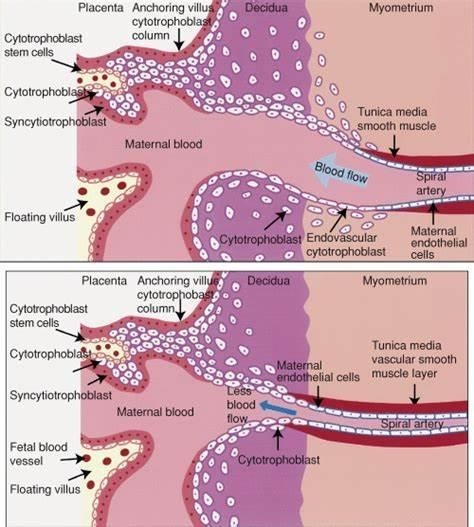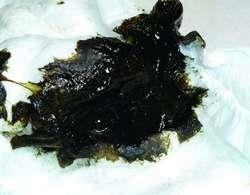A nurse is caring for a client who has preeclampsia and is being treated with magnesium sulfate IV. The client's respiratory rate is 10/min and deep-tendon reflexes are absent. Which of the following actions should the nurse take?
Prepare for an emergency cesarean birth.
Discontinue the medication infusion.
Place the client in Trendelenburg's position.
Assess maternal blood glucose.
The Correct Answer is B
Choice A) Prepare for an emergency cesarean birth is incorrect because this is not a priority or appropriate action for a nurse who is caring for a client who has preeclampsia and is being treated with magnesium sulfate IV.
Preeclampsia is a condition that causes high blood pressure, proteinuria, and edema during pregnancy. It can lead to complications such as eclampsia, which is seizures, or HELLP syndrome, which is hemolysis, elevated liver enzymes, and low platelets. Magnesium sulfate is a medication that helps to prevent or treat seizures in preeclamptic clients by relaxing the muscles and nerves. However, it can also cause side effects such as respiratory depression, hypotension, or loss of reflexes. Preparing for an emergency cesarean birth may be necessary if the client has severe preeclampsia or fetal distress, but it does not address the immediate problem of magnesium toxicity. Therefore, this action should be done only when indicated by the physician and after stabilizing the client's condition.
Choice B) Discontinue the medication infusion is correct because this is a priority and appropriate action for a nurse who is caring for a client who has preeclampsia and is being treated with magnesium sulfate IV. Discontinuing the medication infusion can help to stop or reduce the adverse effects of magnesium sulfate, such as respiratory depression, hypotension, or loss of reflexes. These effects can indicate magnesium toxicity, which is a life-threatening condition that can cause cardiac arrest or coma. The nurse should also notify the physician and prepare to administer calcium gluconate, which is an antidote for magnesium toxicity. Therefore, this action should be done as soon as possible for clients who show signs of magnesium overdose.
Choice C) Place the client in Trendelenburg's position is incorrect because this is not a safe or suitable action for a nurse who is caring for a client who has preeclampsia and is being treated with magnesium sulfate IV.
Trendelenburg's position means lying on the back with the head lower than the feet. It is sometimes used to improve blood flow to the brain or heart in cases of shock or hypotension. However, it can also cause complications such as increased intracranial pressure, decreased lung expansion, aspiration, or acid reflux. Moreover, it does not help to reverse or prevent the side effects of magnesium sulfate, such as respiratory depression, hypotension, or loss of reflexes. Therefore, this action should be avoided or used with caution for clients who are receiving magnesium sulfate IV.
Choice D) Assess maternal blood glucose is incorrect because this is not a relevant or necessary action for a nurse who is caring for a client who has preeclampsia and is being treated with magnesium sulfate IV. Blood glucose is the level of sugar in the blood that provides energy to the cells. It is measured by a blood test or a finger stick test. It can be affected by various factors such as diet, exercise, medication, or pregnancy. Assessing maternal blood glucose may be important for clients who have diabetes or gestational diabetes, which are conditions that cause high blood sugar levels that can harm the mother and the baby. However, it does not relate to preeclampsia or magnesium sulfate, which are conditions that affect blood pressure and nerve function. Therefore, this action should be done only when indicated by the physician and according to the client's history and needs.

Nursing Test Bank
Naxlex Comprehensive Predictor Exams
Related Questions
Correct Answer is D
Explanation
Choice a) Check the baby's diaper is incorrect because this is not a priority action for a baby who is grunting in the neonatal nursery. Grunting is a sign of respiratory distress, which means that the baby is having difficulty breathing and is trying to keep air in the lungs by making a low-pitched sound with each expiration. Checking the baby's diaper may be part of routine care, but it does not address the underlying cause of the grunting or improve the baby's oxygenation. Therefore, this action should be done after assessing and treating the baby's respiratory status.
Choice b) Place a pacifier in the baby's mouth is incorrect because this is not an appropriate action for a baby who is grunting in the neonatal nursery. Grunting is a sign of respiratory distress, which means that the baby is having difficulty breathing and is trying to keep air in the lungs by making a low-pitched sound with each expiration. Placing a pacifier in the baby's mouth may interfere with the baby's breathing and worsen the grunting, as it can obstruct the airway, increase the work of breathing, or cause aspiration. Therefore, this action should be avoided or used with caution for babies who are grunting.
Choice c) Have the mother feed the baby is incorrect because this is not a safe action for a baby who is grunting in the neonatal nursery. Grunting is a sign of respiratory distress, which means that the baby is having difficulty breathing and is trying to keep air in the lungs by making a low-pitched sound with each expiration. Having the mother feed the baby may increase the risk of choking or aspiration, as the baby may not be able to coordinate sucking, swallowing, and breathing. Therefore, this action should be delayed or modified until the baby's respiratory status improves.
Choice d) Assess the respiratory rate is correct because this is the most important action for a baby who is grunting in the neonatal nursery. Grunting is a sign of respiratory distress, which means that the baby is having difficulty breathing and is trying to keep air in the lungs by making a low-pitched sound with each expiration. Assessing the respiratory rate can help to determine the severity and cause of the respiratory distress, as well as guide further interventions such as oxygen therapy, suctioning, or medication. The normal respiratory rate for a newborn ranges from 30 to 60 breaths per minute, and it may vary with sleep or activity. A respiratory rate above 60 breaths per minute or below 30 breaths per minute indicates abnormality and requires immediate attention. Therefore, this action should be done as soon as possible for babies who are grunting.
Correct Answer is D
Explanation
Choice A) Placenta previa is incorrect because this is not a likely complication for a client who has gestational hypertension and reports continuous abdominal pain and vaginal bleeding. Placenta previa is a condition where the placenta covers part or all of the cervix, preventing normal delivery. It can cause painless, bright red bleeding in the third trimester, especially after intercourse or a pelvic exam. However, it does not cause abdominal pain, as the bleeding is not associated with uterine contractions or separation. Moreover, it is not related to gestational hypertension, which is a condition that causes high blood pressure during pregnancy. Therefore, this response is irrelevant and inaccurate.
Choice B) Incompetent cervix is incorrect because this is not a possible complication for a client who is at 36 weeks of gestation and has gestational hypertension and reports continuous abdominal pain and vaginal bleeding.
Incompetent cervix is a condition where the cervix is weak and unable to hold the pregnancy, leading to premature dilation and delivery. It can cause painless, watery vaginal discharge or spotting in the second trimester, followed by rupture of membranes and labor. However, it does not cause abdominal pain or heavy bleeding, as the cervix does not tear or detach from the uterus. Moreover, it is not related to gestational hypertension, which is a condition that causes high blood pressure during pregnancy. Therefore, this response is irrelevant and inaccurate.
Choice C) Prolapsed cord is incorrect because this is not a common complication for a client who has gestational hypertension and reports continuous abdominal pain and vaginal bleeding. Prolapsed cord is a condition where the umbilical cord slips through the cervix and into the vagina before the baby, compressing the cord and cutting off the blood supply and oxygen to the baby. It can cause variable or prolonged fetal heart rate decelerations, visible or palpable cord in the vagina, or fetal distress. However, it does not cause abdominal pain or bleeding, as the cord does not rupture or bleed. Moreover, it is not related to gestational hypertension, which is a condition that causes high blood pressure during pregnancy. Therefore, this response is irrelevant and inaccurate.
Choice D) Abruptio placentae is correct because this is a probable complication for a client who has gestational hypertension and reports continuous abdominal pain and vaginal bleeding. Abruptio placentae is a condition where the placenta separates from the uterine wall before delivery, causing hemorrhage and hypoxia for the mother and the baby. It can cause severe, constant abdominal pain, dark red bleeding, uterine tenderness or rigidity, fetal distress or demise, or maternal shock or coagulopathy. It can be triggered by gestational hypertension, which is a condition that causes high blood pressure during pregnancy and increases the risk of placental abruption by 25%. Therefore, this response is relevant and accurate.

Whether you are a student looking to ace your exams or a practicing nurse seeking to enhance your expertise , our nursing education contents will empower you with the confidence and competence to make a difference in the lives of patients and become a respected leader in the healthcare field.
Visit Naxlex, invest in your future and unlock endless possibilities with our unparalleled nursing education contents today
Report Wrong Answer on the Current Question
Do you disagree with the answer? If yes, what is your expected answer? Explain.
Kindly be descriptive with the issue you are facing.
